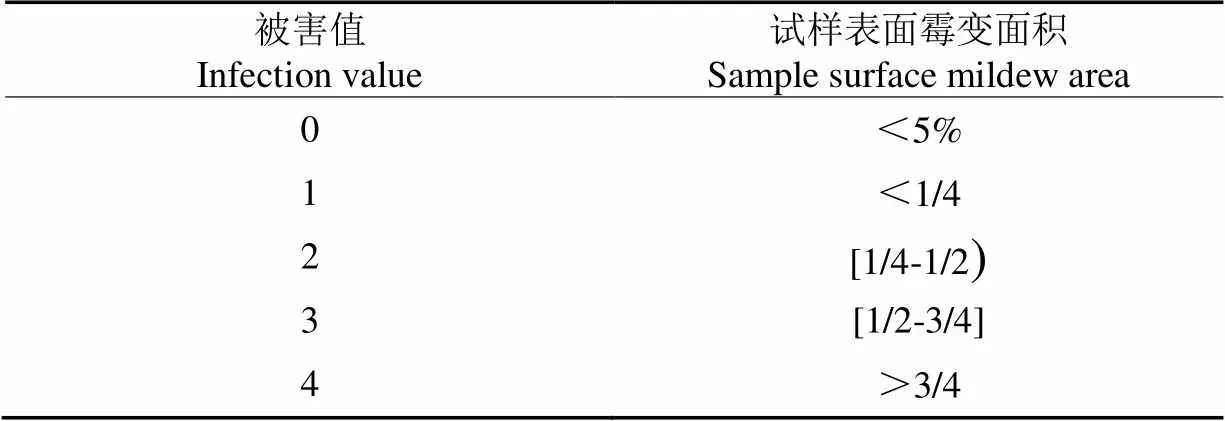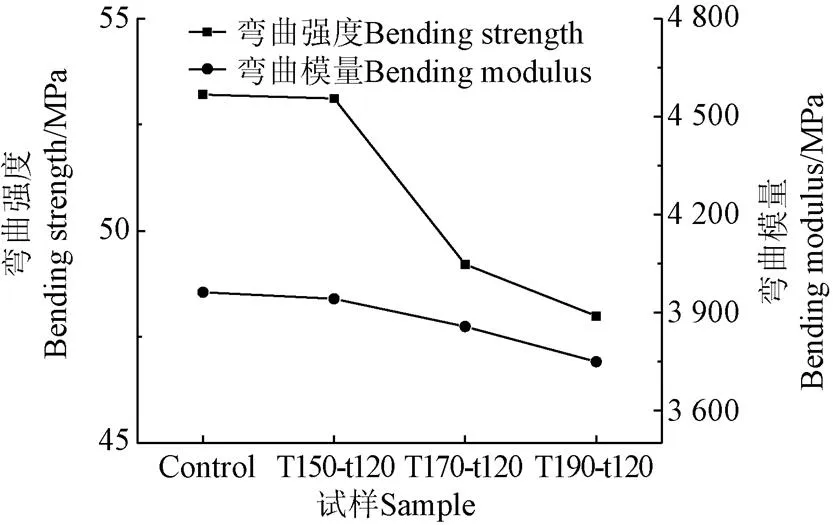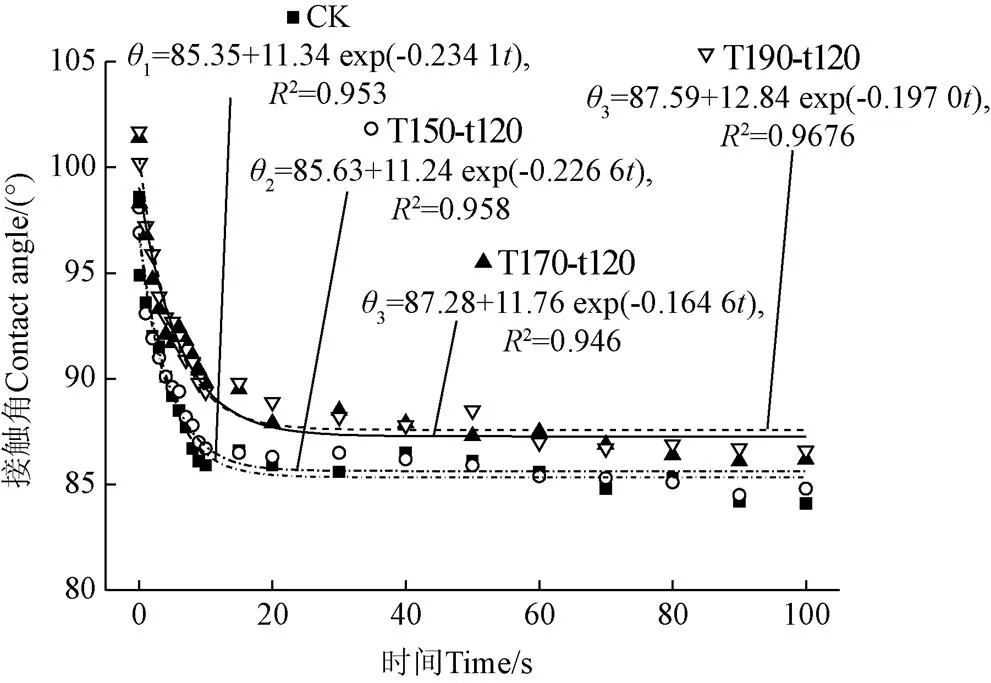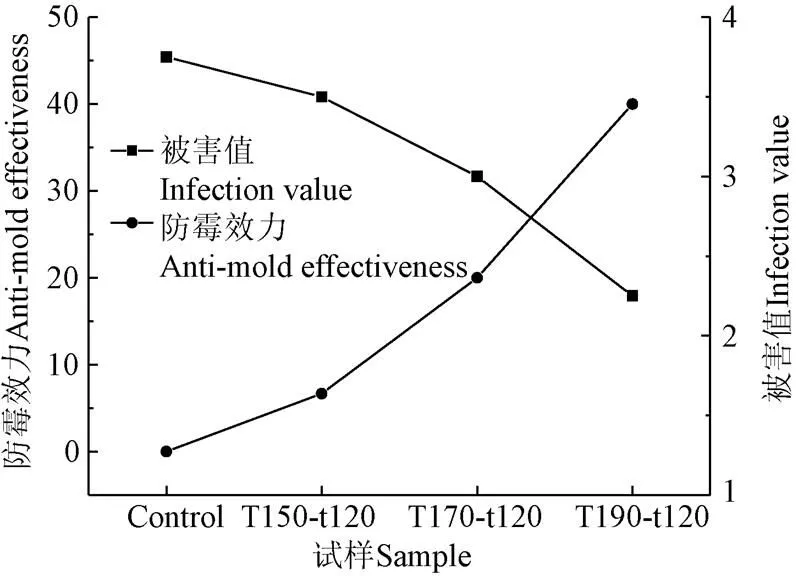竹粉热处理改善竹粉/聚丙烯复合材料的防霉性能
周吓星,苏国基,陈礼辉
竹粉热处理改善竹粉/聚丙烯复合材料的防霉性能
周吓星,苏国基,陈礼辉※
(福建农林大学材料工程学院,福州 350002)
为改善竹粉/聚丙烯(polypropylene,PP)复合材料的防霉性能,该文通过对竹粉进行热处理,处理温度为150~190 ℃、处理时间为60~240 min,研究热处理对竹粉化学成分、失重率及吸湿性的影响,测试热处理竹粉对竹粉/PP复合材料颜色、力学性能、表面润湿性及防霉性能的影响。结果表明:随着热处理温度的升高和热处理时间的延长,竹粉综纤维素含量逐渐降低,木质素含量逐渐增加,失重率增大,吸湿性降低;与未热处理的竹粉/PP复合材料相比,热处理复合材料的色差最大值为7.54,弯曲强度和弯曲模量分别下降9.79%和5.37%,但表面润湿性降低,防霉性能增强,防霉被害值由3.75降至2.25,防霉效力为40%。该研究结果可为防霉型竹(木)塑复合材料的研发和应用提供试验数据和理论参考。
竹粉;聚丙烯;复合材料;木塑;防霉性能;热处理
0 引 言
竹塑复合材料(bamboo plastic composite, BPC)是以竹纤维、竹粉为增强材料或填充材料和热塑性塑料通过挤出法、注塑法、模压法制备的新型环保复合材料。BPC的研究对于缓解木材资源紧张,提高竹材资源综合利用率,加强塑料综合利用具有重要的现实意义[1]。研究表明,竹材中具有含量较高的淀粉、蛋白质、糖类、脂肪等营养物质,极易被微生物侵蚀而发生霉变;BPC的防霉性能劣于含木粉的其他木塑制品,而且随着竹粉含量增加,其防霉性能越差[2]。霉菌的繁殖不仅会影响BPC的外观、力学性能和使用寿命,还会引发人类健康问题,因此,BPC的防霉研究亟需引起高度重视[3]。当前,BPC防霉性能的研究较少,仅有少数学者采用植物纤维预处理[4]、添加抗菌防霉剂[5]、植物纤维抽提的方法[6]改善木塑复合材料的防霉性能;而竹材的防霉研究较多,主要采用超声法[7]、添加植物提取物[8]、添加纳米抗菌剂[9]、添加防霉剂[10]、浸渍处理[11]、淀粉酶处理[12]等方法,但存在工序复杂、性价比不高及环保等问题。研究发现,热处理技术可以降低植物纤维的吸湿性[13-14],提高木质材料的尺寸稳定性[15-16]和耐候性[17],是一种良好的环保型植物纤维改性技术;而且有研究认为适当的热处理技术可以改善竹材[18-19]及竹塑复合材料[20-22]的热力学性质等。因此,本文采用热压法制备高竹粉含量的竹粉/ 聚丙烯(polypropylene,PP)复合材料,试图采用热处理竹粉技术改善竹粉/PP复合材料的防霉性能,探讨热处理对竹粉化学成分、失重率、吸湿性及颜色的影响,同时分析热处理竹粉对竹粉/PP复合材料颜色、力学性能、表面润湿性及防霉性能的影响。
1 试验材料与方法
1.1 试验材料
竹粉:将福建省三年生毛竹舍去竹节部分切成竹片后,用植物粉碎机粉碎,筛取40~60目(250~420m);PP:牌号K8303、熔融指数(melt index,MI)为2.6 g/10 min(230 ℃,2.16 kg)、中国石化北京燕山分公司;高熔体强度聚丙烯(high melted strength polypropylene, HMSPP),牌号SMS-514F、MI为3.2 g/10 min、韩仁贸易上海有限公司;马来酸酐接枝聚丙烯(maleic anhydride modified polypropylene, MAPP),接枝率为1.09%,南京德巴化工有限公司;硬脂酸、硬脂酸钙均为市售;试验菌种为桔青霉、绿色木霉、黑曲霉的等质量混合菌种,广东省微生物菌种保藏中心;甲苯、乙醇、硫酸,国药集团化学试剂有限公司。
1.2 竹粉的热处理改性
将含水率为0的竹粉分别放置在温度为150、170、190 ℃的烘箱中热处理60、120、240 min,得到9组热处理竹粉试样,并以未热处理的竹粉作为对照。
1.3 竹粉/PP复合材料制备
将150、170和190 ℃温度下热处理120 min的竹粉放入105 ℃烘箱中,干燥10 h至绝干。将未热处理的干燥竹粉和经过上述3种工艺热处理的干燥竹粉分别与PP、HMSPP、MAPP、润滑剂(硬脂酸和硬脂酸钙以1:1混合)放入高速混合机中,竹粉、PP、HMSPP、MAPP和润滑剂分别占复合材料质量的60%、28%、7%、4%和1%,混合升温至120 ℃后继续混合10 min制成初混料;将初混料放入转矩流变仪中密炼8 min,密炼温度180 ℃、转速50 r/min,卸料后粉碎成粒径为2~10 mm的竹塑粒子;将烘干的竹塑粒子平铺在模具中,放入热压机成型,预压温度178 ℃,预压时间15 min,热压温度180 ℃,热压压力1.5 MPa,热压时间10 min,冷却至60 ℃时卸板取样。
1.4 试验方法
1.4.1 竹粉化学成分测定
参考美国国家可再生能源实验室方法定量测定竹粉中的纤维素、半纤维素和木质素含量[18]。将苯醇抽提过的竹粉用72%的浓硫酸和4%的稀硫酸2步水解,采用生化分析仪测定纤维素水解生成的葡萄糖含量,折算得到纤维素的相对含量;采用高效液相色谱法测定半纤维素水解生成的木糖和阿拉伯糖,折算得到半纤维素的相对含量;过滤得到的滤渣经过充分水洗后在105 ℃烘箱中干燥,称质重计算得到木质素的相对含量。
1.4.2 竹粉失重率和吸湿性测定
采用天平称量热处理前后竹粉的质量,天平的精度为0.01 g,按公式(1)计算竹粉失重率(mass loss,ML),试验结果为5个平行试样测试结果的算术平均值。

式中1为热处理前竹粉的绝干质量,2为热处理后竹粉的绝干质量,g。
将绝干质量为0的竹粉放入相对湿度为85%、温度为28 ℃的环境中直至达到吸湿解吸平衡状态,称取平衡状态时试样的质量为W,按公式(2)计算竹粉的平衡含水率(equilibrium moist content,EMC),试验结果为5个平行试样测试结果的算术平均值。

1.4.3 竹粉/PP复合材料表面颜色测试
根据CIE1976L*a*b*颜色体系,*为白度,*为红绿轴色指数,*为黄蓝轴色指数,采用分光光度测色仪测试热处理前后BPC的颜色变化。按照公式(3)计算色差∆E;每个试样测试3个不同部位,试验结果为4个平行试样测试结果的算术平均值。

式中∆*为白度变化量,∆*为红绿轴色指数变化量,∆*为黄蓝轴色指数变化量。
1.4.4 竹粉/PP复合材料力学性能测定
参照GB/T 9341-2008[23],采用万能力学试验机对复合材料试样进行3点弯曲强度和弯曲模量测试,测试热处理竹粉对试样弯曲性能的影响。试样尺寸为80 mm× 10 mm×3 mm,加载速度为10 mm/min,跨距为48 mm,试验结果为5个平行试样测试结果的算术平均值。
1.4.5 竹粉/PP复合材料表面接触角的测定
采用表面接触角测定仪测量复合材料的表面接触角,采用的测试液体为体积5L的蒸馏水。按动态润湿性模型公式(4),运用非线性曲线拟合试验数据,通过值定量评价热处理竹粉对试样表面润湿性的影响。

式中为时刻的接触角,θ为平衡接触角,(°);为积分常数;为接触角在单位时间内衰减的速率常数。
1.4.6 竹粉/PP复合材料霉变性能测试
参照GB/T 18261-2013[24],将复合材料试样接菌后放回培养箱培养4周,培养箱保持温度为28 ℃,相对湿度为85%。试样尺寸为50 mm×50 mm×3 mm,根据表1所示试样被害值分级标准及公式(5)计算试样的防霉效力,被害值越低,材料的防霉效果越好。

式中为防霉效力,%;1、0分别为热处理竹塑试样和未热处理竹塑试样的被害值。

表1 竹粉/PP复合材料的被害值
2 结果与分析
2.1 热处理对竹粉化学成分、失重率和吸湿性的影响
表2为热处理对竹粉纤维素、半纤维素和木质素的相对含量及失重率、吸湿性的影响。由表2可见,未处理竹粉的纤维素含量为41.79%,半纤维素含量为25.25%,木质素含量为28.05%;随着热处理温度的升高及热处理时间的延长,总体上纤维素和半纤维素的含量逐渐减少,木质素含量逐渐增加,这与Zhang等[25]的研究结果一致。Meng等[15]通过傅立叶红外光谱和X射线光谱分析也证实了热处理竹粉会导致半纤维素和纤维素含量降低,木素含量增加。与未处理竹粉相比,150 ℃处理60、120、240 min时,竹粉中综纤维素(纤维素和半纤维素之和)含量分别下降了0.19、0.53和0.55个百分点,木质素含量变化很小;170 ℃处理60、120、240 min时,纤维素含量分别减少了0.87、1.00和1.21个百分点,半纤维素含量分别减少了1.04、1.99和1.65个百分点,木质素含量相应逐渐增大,与纤维素含量的变化相比,半纤维素含量变化更为明显,这与半纤维素的支链结构和无定形组织有关,热稳定性最差、聚合度低的半纤维素最先开始发生降解;热处理温度升高至190 ℃时,纤维素和半纤维素含量明显下降,热处理60、120、240 min时,综纤维素含量分别下降了6.03、7.00和8.87个百分点,木质素含量分别增大了1.16、2.92和2.52个百分点。热处理竹粉半纤维素中的碳水化合物发生明显热降解,引起阿拉伯糖、半乳糖、木糖和甘露糖等含量的降低,而纤维素发生少量热降解,产生自由基攻击纤维素内部分子链,造成链滑移并断裂生成半缩醛或糖醛酸等短链物质[15]。热处理竹粉木质素含量的增加一方面是由于半纤维素和纤维素发生降解、多糖含量减少;另一方面可能是由于热处理过程中碳水化合物降解生成的低分子物质吸附在测定的木质素上,形成类似于假木素的聚合多糖物质,造成测定木素含量的相对提高[26]。150 ℃热处理60~240min 时,竹粉失重率为0.98%~1.54%;随着热处理温度的升高,竹粉的失重率逐渐增大,190 ℃热处理240 min时,竹粉的失重率增至最大,为6.16%。Zhang等[25]研究发现,热处理竹粉的失重率与其化学成分发生变化有着密切的数学关系,部分半纤维素和少量纤维素发生降解是导致竹粉质量降低的重要原因。楠竹经历160 ℃热处理240 min时,失重率仅为2.9%;但楠竹经历180 ℃热处理240 min时,失重率达到7.4%[25]。由此可见,不同种类木材及竹材经历相同温度及时间热处理产生的失重率不同,失重率的大小还与材料的3大素结构、半纤维素的主要成分及木聚糖的热稳定性有关。热处理可明显降低竹粉的吸湿性,且EMC的变化趋势与失重率一致。竹粉吸湿性的下降是多种因素综合作用的结果:热处理过程中,半纤维素发生热降解,细胞壁中自由羟基数量减少;细胞壁微观结构发生变化,封闭了原本水分可以接触到的极性基团[27];高温作用下木质素塑性增加,且木质素在热处理过程中可能发生缩合反应[13],阻止竹粉对水分的吸收。
热处理时间从60 min延长至240 min时,竹粉化学成分、失重率和吸湿性的变化幅度小于热处理温度从150 ℃升温至190 ℃时,可见热处理温度对竹粉的影响小于热处理温度;相同热处理温度下,热处理时间从60 min延长至120 min时,竹粉上述3个指标有一定变化,但继续延长至240 min时,其变化趋势减小;因此,为减少竹粉改性能耗和成本,后续改善复合材料防霉性能时,固定热处理温度为120 min。

表2 热处理对竹粉化学成分、失重率和平衡含水率的影响
注:T150-t60指的是经过150 ℃热处理60 min,以此类推,下同。
Note: T150-t60 meants the bamboo powder heat-treated at 150 ℃ for 60 min, and so on, the same as below.
2.2 热处理对竹粉/PP复合材料表面颜色的影响
图1为不同温度热处理120 min后竹粉的表观图。由图1可见,未处理竹粉为浅黄色,150 ℃处理后竹粉变成浅咖啡色,随着热处理温度升高,竹粉颜色继续加深变黑,190 ℃处理后竹粉变成深褐色。一方面,低分子碳水化合物半纤维素在高温作用下会分解产生具有发色基团的酚类物质和醋酸,醋酸会进一步催化木质素和纤维素的降解,从而加深竹粉的颜色;而且180 ℃以上时木质素-醚键发生均裂,生成的自由基引发链反应形成的过氧化物也会加剧竹粉变色。另一方面,木质素或抽提物在高温作用下会发生变化,竹粉中发色基团和助色基团也随之变化[28]。

图1 竹粉热处理对竹粉颜色的影响
霉变前后热处理竹粉/PP复合材料的颜色参数见表 3。由表3可见,与未处理竹粉制备的复合材料相比,霉变试验前热处理竹粉制备的复合材料*明显降低,这与竹粉的变化一致,主要也是因为热处理竹粉的颜色变黑;150、170、190 ℃热处理120 min后,*分别下降了0.09、2.04和5.47;150 ℃时,D*为0.51,170 ℃和190 ℃时,D*分别为−1.11和−3.03;*与*的变化趋势一样,随着热处理温度上升呈现逐渐减少趋势,190 ℃时,D*为−4.22。随着热处理温度升高,热处理对复合材料颜色的影响越来越明显,色差D*最大为7.54。但是,热处理竹粉制备的复合材料,霉变试验前后的颜色变化不大,150、170、190 ℃热处理的复合材料的*分别增大了0.95、1.23和0.87,*分别减小了1.24、0.53和0.3,*分别增大了1.68、0.31和0.2,材料颜色轻微地向偏绿和偏黄方向变化;D*分别为2.29、1.37和0.94。由色差与视觉的关系可知[29],170 ℃和190 ℃热处理竹粉后,竹粉/PP复合材料在霉变过程中的颜色稳定性较好,霉菌对复合材料的颜色影响很小。

表3 竹粉热处理对竹粉/PP复合材料霉变前后颜色的影响
2.3 热处理对竹粉/PP复合材料力学性能的影响
图2为不同热处理竹粉对竹粉/PP复合材料弯曲性能的影响。由图2可见,随着热处理温度上升,竹粉/PP复合材料的弯曲性能逐渐下降。与未处理的复合材料相比,150 ℃时,复合材料的弯曲强度和弯曲模量分别下降了0.17%和2.67%;170 ℃时,复合材料的弯曲强度明显下降,弯曲模量继续缓慢下降;190 ℃时,BPC的弯曲强度和弯曲模量分别下降了9.79%和5.37%。Zhang等[25]研究表明,热处理引起的竹粉化学成分变化及失重率增大是竹材弯曲性能变化的主要原因。Ying等[20]研究也表明,热处理竹粉的纤维素结晶结构会发生变化,从而影响竹粉/PP复合材料的拉伸和冲击强度。

图2 竹粉热处理对竹粉/PP复合材料力学性能的影响
2.4 热处理对竹粉/PP复合材料表面润湿性的影响
图3为不同热处理竹粉制备的竹粉/PP复合材料的表面接触角随时间的关系曲线。由图3可见与未处理竹粉/PP复合材料相比,热处理复合材料的初始接触角呈增大趋势、平衡接触角也随之增加;值呈现降低趋势,表明复合材料表面润湿性降低。未处理复合材料的初始接触角为98.6°,通过曲线拟合计算的平衡接触角为85.35°,接触角衰减速率值为0.2341;150 ℃时,复合材料的表面润湿性变化不大;170 ℃时,复合材料的初始接触角和平衡接触角分别增至101.4°和87.28°,值降低至0.164 6;热处理温度升高至190 ℃时,复合材料的表面润湿性不再继续降低。

图3 竹粉热处理对竹粉/PP复合材料表面润湿性的影响
2.5 热处理对竹粉/PP复合材料霉变性能的影响
图4为竹粉/PP复合材料经历4周霉变试验后的表观图。由图4可见,未热处理的复合材料试样表面几乎全部感染霉菌,随着热处理温度升高,霉菌生长面积逐渐减小,尤其是190 ℃时,试样表面霉菌的生长受到明显抑制。
对霉菌生长面积经过分析计算得到的竹粉/PP复合材料的被害值和防霉效力见图5。由图5可见,未处理复合材料的霉变被害值为3.75,随着热处理温度的升高,被害值逐渐下降,防霉效力逐渐提高,尤其是热处理温度为190 ℃时,试样的被害值降低至2.25,防霉效力提高至40%。由此可见,热处理竹粉一定程度上可以提高竹粉/PP复合材料的防霉性能。从前文分析来看,热处理后复合材料的吸湿性和表面润湿性降低,有效减少了霉菌生长所需的湿度条件。而且,热处理过程中,多糖含量的降低有助于减少霉菌的营养物质,竹粉中木质素的降解也有助于生成改善复合材料耐久性的木酚素[30]。

图4 不同热处理竹粉/PP复合材料的防霉效果图

图5 竹粉热处理对竹粉/PP复合材料防霉性能的影响
3 结 论
1)150 ℃热处理60~240 min时,竹粉化学成分变化不大,170 ℃和190 ℃热处理时,随着热处理温度的升高及热处理时间的延长,竹粉纤维素和半纤维素的含量逐渐减少,木质素的含量逐渐增大;热处理过程中竹粉失重率的增大与其化学成分的变化直接相关。
2)热处理降低竹粉的吸湿性,而且降低了竹粉/PP复合材料的表面润湿性;热处理温度提高会加深竹粉颜色,从而改变复合材料的表观颜色,与未处理复合材料相比,190 ℃热处理120 min时,复合材料的色差为7.54,但是其霉变试验时的颜色稳定性更好,霉变前后的色差仅为0.94。
3)热处理会降低竹粉/PP复合材料的弯曲性能,与未处理复合材料相比,190 ℃热处理120 min时,复合材料的弯曲强度和弯曲模量分别下降了9.79%和5.37%;但是其防霉效力提高至40%。
[1] 周吓星,陈礼辉,林巧佳. 竹粉/聚丙烯复合材料的增韧效果[J]. 农业工程学报,2013,29(2):266-272.
Zhou Xiaxing, Chen Lihui, Lin Qiaojia. Toughening effect of bamboo flour/polypropylene foamed composite[J]. Transactions of the Chinese Society of Agricultural Engineering (Transactions of the CSAE), 2013, 29(2): 266-272. (in
Chinese with English abstract)
[2] 刘永龙,陈娟,刘丽瑜,等. 影响木塑复合材料耐霉性能的因素分析[J]. 工业微生物,2015,45(5):55-59.
Liu Yonglong, Chen Juan, Liu Liyu, et al. Analysis of factors affecting anti-mildew properties of wood-plastic composites[J]. Industrial Mircrobiology, 2015, 45(5): 55-59. (in Chinese with English abstract)
[3] 苏国基,周吓星,黄六莲,等. 硅烷改性纳米氧化锌改善竹塑复合材料的防霉性能[J]. 塑料工业,2016,44(5):88-92.
Su Guoji, Zhou Xiaxing, Huang Liulian, et al. Anti-mold performance of bamboo plastic composites with silane modified nano zinc oxide [J]. Plastic Industry, 2016, 44(5): 88-92. (in Chinese with English abstract)
[4] 刘丁宁,何春霞,薛娇,等. 理化预处理麦秸改善其聚丙烯复合材料抗霉菌腐蚀力学性能[J]. 农业工程学报,2016,32(17):309-314.
Liu Dingning, He Chunxia, Xue Jiao, et al. Physicochemical pretreatments of wheat straw improving fungus corrossion resistance and mechanical properties of wheat straw/ polypropylene composites[J]. Transactions of the Chinese Society of Agricultural Engineering (Transactions of the CSAE), 2016, 32(17): 309-314. (in Chinese with English abstract)
[5] Feng Jing, Shi Qingshan, Chen Yiben, et al. Mold resistance and water absorption of wood/HDPE and bamboo/HDPE composites[J]. Journal of Applied Sciences, 2014, 14(8): 776-783.
[6] Hosseinaei Omid, Wang Siqun, Taylor Adam M, et al. Effect of hemicellulose extraction on water absorption and mold susceptibility of wood-plastic composites[J]. International Biodeterioration & Biodegradation, 2012, 71(4): 29-35.
[7] 周明明,王路,雍宬,等. 超声与铜唑浸渍处理对竹材防霉效果的影响[J]. 竹子研究汇刊,2012,31(4):31-33.
Zhou Mingming, Wang Lu, Yong Cheng, et al. Anti-mold effects of ultrasonic and CuAz impregnation treatments on bamboo[J]. Journal of Bamboo Research, 2012, 31(4): 31-33. (in Chinese with English abstract)
[8] Xu Guoqi, Wang Lihai, Liu Junliang, et al. Decay resistance and thermal stability of bamboo preservatives prepared using camphor leaf extract[J]. International Biodeterioration & Biodegradation, 2013(78): 103-107.
[9] 杨优优,卢凤珠,鲍滨福,等. 载银二氧化钛纳米抗菌剂处理竹材和马尾松的防霉和燃烧性能[J]. 浙江农林大学学报,2012,29(6):910-916.
Yang Youyou, Lu Fengzhu, Bao Binfu, et al. Mould and fire resistance oftreated with a nano antibiotic agent, TiO2doped-Ag[J]. Journal of Zhejiang Agriculture & Forestry University, 2012, 29(6): 910-916. (in Chinese with English abstract)
[10] 王杰,廖颖艺,罗刚,等. 壳聚糖铜配合物与有机EP对慈竹的防霉效果[J]. 东北林业大学学报,2017,45(2):81-84.
Wang Jie, Liao Yingyi, Luo Gang, et al. Anti-mold effects of CCC and organic EP on[J]. Journal of Northeast Forestry University, 2017, 45(2): 81-84. (in Chinese with English abstract)
[11] 刘彬彬,张绍勇,周月英,等. 浸渍处理对竹材霉变性能的影响[J]. 浙江农林大学学报,2015,32(1):11-17. Liu binbin, Zhang Shaoyong, Zhou Yueying, et al. Mildew in bamboo flour treated with different solvents[J]. Journal of Zhejiang Agriculuture and Forestry University, 2015, 32(1): 11-17. (in Chinese with English abstract)
[12] Huang X D, Hse C Y, Shupe T F. Study on the mould- resistant properties of Moso bamboo treated with high pressure and anylase[J]. Bioresources, 2013, 9(1): 497-509.
[13] Seyyed Khalil Hosseinihashemi, Farhad Arwinfar, Abdollah Najafi. Long-term water absorption behavior of thermoplastic composites produced with thermally treated wood[J]. Measurement, 2016, 86: 202-208.
[14] Deniz Aydemir, Alper Kiziltas, Esra Erbas Kiziltas, et al. Heat treated wood-nylon 6 composites[J]. Composites: Part B, 2015, 68: 414-423.
[15] Meng Fandan, Yu Yanglun, Zhang Yamei, et al. Surface chemical composition analysis of heat-treated bamboo[J]. Applied Surface Science, 2016, 371: 383-390.
[16] Haci Ismail Kesik, Suleyman Korkut, Salim Hiziroglu, et al. An evaluation of properties of four heat treated wood species[J]. Industrial Crops and Products, 2014, 60(1): 60-65.
[17] Eylem D Tomak, Derya Ustaomer, Sibel Yildiz, et al. Changes in surface and mechanical properties of heat treated wood during natural weathering[J]. Measurement, 2014, 53: 30-39.
[18] 范文俊,涂登云,彭冲,等. 热处理对毛白杨木材力学性能的影响机理[J]. 东北林业大学学报,2015,43(10):88-91.
Fan Wenjun, Tu Dengyun, Peng Chong, et al. Influence of heat treatment on mechanical properties ofwood [J]. Journal of Northeast forestry University, 2015, 43(10): 88-91. (in Chinese with English abstract)
[19] Cheng D, Jiang S, Zhang Q. Effect of hydrothermal treatment with different aqueous solutions on the mold resistance of moso bamboo wth chemical and FTIR analysis[J]. Bioresources, 2013, 8(1): 371-382.
[20] Ying Sanjiu, Wang Chuanbao, Lin Qing. Effects of heat treatment on the properties of bamboo fiber/polypropylene composite[J]. Fibers and Polymers, 2013, 14(11): 1894-1898.
[21] Li Tao, Cheng Dali, Wålinder MEP, et al. Wettability of oil heat-treated bamboo and bonding strength of laminated bamboo board[J]. Industrial Crops & Products, 2015, 69: 15-20.
[22] 张红漫,郑荣平,陈敬文,等. NREL法测定木质纤维素原料组分的含量[J]. 分析试验室,2010,29(11):15-18.
Zhang Hongman, Zheng Rongping, Chen Jingwen, et al. Investigation on the determination of lignicellulosics components by NREL method[J]. Chinese Journal of Analysis Laboratory, 2010, 29(11): 15-18. (in Chinese with English abstract)
[23] 塑料弯曲性能的测定,GB/T 9341-2008[S]. 2008.
[24] 防霉剂对木材霉菌及变色菌防治效力的实验室及户外试验方法,GB/T 18261-2013[S]. 2013.
[25] Zhang Yamei, Yu Yanglun, Yu Wenji.Effect of thermal treatment on the physical and mechanical properties ofbamboo[J]. European Journal of Wood Product, 2013, 71: 61-67.
[26] 马晓娟. 竹材预水解碳水化合物溶出规律及其降解机制研究[D]. 福州:福建农林大学,2014.
Ma Xiaojuan. Study on the Rule and Mechanism of the Degradation of the Carbohydrate Digestion of Bamboo[D]. Fuzhou: Fujian Agriculture and Forestry University, 2014. (in Chinese with English abstract)
[27] 丁涛,顾炼百,蔡家斌. 热处理对木材吸湿特性及尺寸稳定性的影响[J]. 南京林业大学学报:自然科学版,2015,39(2):143-147.
Ding Tao, Gu Lianbai, Cai Jiabin. Effects of heat treatment on the moisture adsorption characteristic and dimensional stability of wood[J]. Journal of Nanjing Forestry University: Natural Science Edition, 2015, 39(2): 143-147. (in Chinese with English abstract)
[28] 成真,刘迎涛. 热处理木材的材色变化研概述[J]. 安徽农业科学,2015,43(15):174-176.
Cheng Zhen, Liu Yingtao. Review on the color change of heat-treated wood[J]. Journal of Anhui Agriculture Science, 2015, 43(15): 174-176. (in Chinese with English abstract)
[29] 周吓星,黄舒晟,苏国基,等. 冻融循环老化降低竹粉/聚丙烯发泡复合材料性能[J]. 农业工程学报,2014,30(10):285-292.
Zhou Xiaxing, Huang Shusheng, Su Guoji, et al. Effects of freeze-thaw cycles weathering on the properties of bamboo flour-polypropylene foaming composites[J]. Transactions of the Chinese Society of Agricultural Engineering (Transactions of the CSAE), 2014, 30(10): 285-292. (in Chinese with English abstract)
[30] Esteves B M, Pereira H M. Wood modification by heat treatment: a review[J]. Bioresources, 2009, 4(1): 370-404.
Heat-treated bamboo powder improves anti-mold performance of bamboo powder/polypropylene composites
Zhou Xiaxing, Su Guoji, Chen Lihui※
(,350002)
Bamboo fiber possesses excellent innate properties such as fast growing, high tensile modulus, high wear resistance, biodegradability, and is a cheaper substitute for glass fiber and carbon fiber. To make full use of bamboo resources in China, research and development of bamboo powder (BP) reinforced plastic is a good way. As we know, bamboo plastic composite (BPC) has broad applications including building, decoration, packing, and automobile manufacturing. BP contains high content of starch, protein, carbohydrate, fat, and other nutrients and thus is vulnerable to microorganisms. Researches showed that the anti-mold performance of BPC was inferior to other wood plastic composite (WPC) and the anti-mildew performance of BPC became worse with the increase of the BP content. The proliferation of mold not only affects the appearance, mechanical properties, and service life of the BPC, but also raises human health issues. Therefore, study on the anti-mold performance of BPC is of great significance. Heat treatment is a good modification method to improve the water resistance, dimension stability, and durability of plant fiber-based materials. In this paper, BP/polypropylene composites with 60% BP were prepared by hot pressed molding and the BP was heat-treated at the temperature of 150, 170 and 190 ℃ respectively for 120 min. Three common types of mould i.e.,,were used to conduct mildew test. The effects of heat treatment on the BP chemical content, mass loss, and hygroscopicity were studied. The influences of heat treatment on the composites surface color, mechanical properties, surface wettability, and anti-mold property were also investigated. The results showed that the BP chemical content did not vary much at the heat temperature of 150 ℃, and the BP cellulose and hemicellulose content gradually decreased and the lignin content accordingly increased with the increase of heat temperature. The heat-treated time of 60, 120, and 240 min had less influence on the BP chemical content than the temperature ranging from 150 to 190 ℃. The increase of mass loss and the reduction of equilibrium moist content (EMC) for the heat-treated BP were directly related to the change of chemical composition. After heat treatment at 190 ℃ for 120 min, the BP holocellulose dropped by 7.00 percentage points, the lignin enhanced by 2.92 percentage points, the mass loss was 4.41 percentage points, and EMC was 6.39%. Compared with the untreated composite, the heat treated composites possessed lower surface wettability, lower bending properties, but higher color stability during mold test and stronger anti-mold performance. The 190 ℃ heat-treated composite became darker and slightly turned green and blue; the lightness change was -5.47, and the color change was 7.54; the bending strength and bending modulus were reduced by 9.79% and 5.37%, respectively. Compared to composite without mildew test, the lightness change, redness change, and yellowness change of tested composite were 0.87, -0.30 and 0.20, respectively, and the color change was only 0.94; the mold resistance value was decreased from 3.75 to 2.25 and the anti-mold effectiveness was increased to 40%. This paper provides experimental data and theoretical reference for the development and application of mold-resistant BPC and WPC.
bamboo; polypropylene (PP); composite materials; wood plastic; anti-mold properties; heat treatment
10.11975/j.issn.1002-6819.2017.24.040
TB332
A
1002-6819(2017)-24-0308-07
2017-07-31
2017-09-04
福建省科技厅引导性项目(2015H0011)
周吓星,女,福建平潭人,副教授,博士,主要从事生物质复合材料研究。Email:star11110818@163.com
陈礼辉,男,福建浦城人,教授,博士,博士生导师,主要从事植物资源利用与新材料研究。Email:lihuichen@263.net
周吓星,苏国基,陈礼辉.竹粉热处理改善竹粉/聚丙烯复合材料的防霉性能[J]. 农业工程学报,2017,33(24):308-314. doi:10.11975/j.issn.1002-6819.2017.24.040 http://www.tcsae.org
Zhou Xiaxing, Su Guoji, Chen Lihui. Heat-treated bamboo powder improving anti-mold performance of bamboo powder/polypropylene composites[J]. Transactions of the Chinese Society of Agricultural Engineering (Transactions of the CSAE), 2017, 33(24): 308-314. (in Chinese with English abstract) doi:10.11975/j.issn.1002-6819.2017.24.040 http://www.tcsae.org

